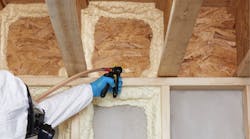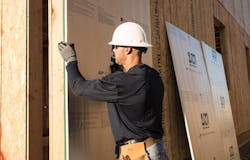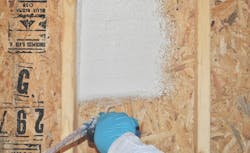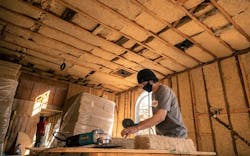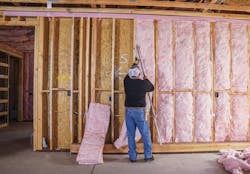5 Insulation Products for a More Energy-Efficient Home
When it comes to home insulation products, much of the focus today relates to an increasing demand for energy efficiency and sustainability, taking into consideration the product’s global warming potential (GWP) and ozone depletion potential (ODP).
Selecting insulation is a process, one in which home builders must weigh a variety of factors, from climate and the material's insulating ability (R-value) to considerations about soundproofing, flammability, and possible allergens. In addition, an increasing number of municipalities are adopting more stringent energy codes, and homebuyer awareness about home energy efficiency and its potential to lower energy bills is growing. Add to these considerations the fact that builders are feeling the squeeze of labor and materials price increases, which in turn drives them to seek out more cost-efficient alternatives where possible.
The good news: There’s an ever-expanding range of home insulation options that can be used in combination to optimize their respective benefits; even manufacturers of tried-and-true products continue to look for ways to innovate and improve with new formulations. Read on for the latest in insulation products.
RELATED
- Batts Done Right—Insulation Best Practice
- Achieving Comfort Above the Garage: How to Build and Insulate
- How to Frame Walls That Combat Moisture
5 New Home Insulation Products
Polyiso Insulation Board From Johns Manville
Johns Manville says the exceptional heat, moisture, and air control provided by its AP Foil-Faced Polyiso Continuous Insulation board effectively protects a building’s exterior wall assembly. The non-structural insulation board consists of a uniform closed-cell polyisocyanurate foam core bonded on each side to a foil facer—reflective foil on one side and a white, non-reflective foil on the other. In addition to polyiso’s high R-values (R-6.0 per inch), when properly installed, the product also functions as a water-resistive barrier, vapor barrier, and air barrier, which eliminates the need to install additional components. The board is made with an EPA-compliant hydrocarbon-based blowing agent that has zero Ozone Depletion Potential (ODP) and virtually no GWP, the company says. It also meets both CFC- and HCFC-free specification requirements. Boards are lightweight and can be cut with a utility knife or saw. Click for more info (Select the "November online" issue from the dropdown menu, then click the checkboxes for any products you'd like more information about.)
ICP’s Improved Spray Foam
ICP Building Solutions Group has launched a reformulation of its HandiFoam E84 product—a two-component, closed-cell spray polyurethane foam system designed for large voids and surfaces. HandiFoam E84 Low GWP offers improved performance, lower global warming potential (GWP), and 30% greater adhesion, the company says. The improved formulation also provides a 2.5-inch Class 1 fire rating and is UL Greenguard Gold certified and fully compliant for use in U.S. states that have implemented regulations phasing out high-GWP blowing agents in low-pressure polyurethane spray foams. Click for more info
DuPont Reformulates Froth-Pak for Reduced GWP
The latest step in the evolution of DuPont's Froth-Pak brand, the all-in-one polyurethane low-pressure spray foam kit for contractors utilizes a blowing agent package that achieves a reduction in GWP of more than 99%, according to the company, compared with blowing agents used in past formulations. Polyurethane spray foam contains no ozone depleting chemicals or HFCs, according to DuPont, while elevating the insulation’s performance attributes. Used to fill larger gaps and penetrations, Froth-Pak seals out moisture, dust, allergens, and pests while improving energy efficiency, building resilience, and home comfort. Product options include: Froth-Pak Spray Foam Sealant and Froth-Pak Spray Foam Insulation. Click for more info
Plant-Based Insulation From Hempitecture
Hempitecture HempWool is a sustainable fiber insulation that is a one-to-one replacement for conventional insulation products in residential and commercial construction, the company says. The plant-based product, which captures carbon dioxide to help build healthier, more sustainable homes, comes in several depths and widths: 2-inch R-7, 3.5-inch R-13, 5.5-inch R-20, and 7.5-inch R-28, with widths to fit 16-inch or 24-inch OC framing. While it is installed like other batt insulation, HempWool differs from traditional batts due to its semi-rigid structure, which allows for a friction fit inside the wall cavity to reduce the likelihood of slumping or thermal bridging inside the wall. Click for more info
Owens Corning Strives for Better Batts
Owens Corning's Pink Next Gen Fiberglas insulation uses advanced fiber technology to create a tightly woven network of soft, fine fibers, forming a super-resilient blanket of insulating micro-pockets. The product recovers instantly and its soft feel makes it easier to handle and split cleanly to completely fill framing cavities. This latest evolution of Owens Corning insulation delivers increased precision and productivity for contractors, according to the company, while making homes more comfortable and having a positive impact on the environment. Click for more info
